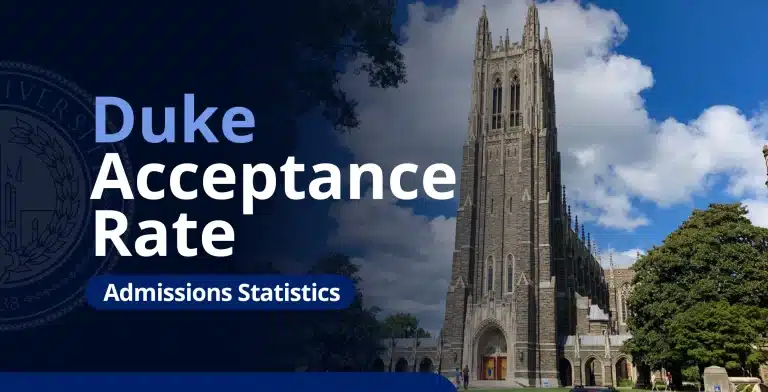With its acceptance rate hitting a record low of 4.8% for the Class of 2029, Duke University has firmly established itself as one of the hardest schools to get into. If you’re dreaming of becoming a Blue Devil, getting a handle on the Duke acceptance rate is essential.
In this blog, we’ll unpack everything about Duke’s acceptance rate—how it’s evolved, what it means, and what it takes to snag a spot at this prestigious school.
- What Is Duke’s Acceptance Rate?
- Duke Acceptance Rate Trends
- Duke Regular Decision Acceptance Rate
- Duke Early Decision Acceptance Rate
- How to Get Accepted into Duke
- Duke Transfer Acceptance Rate
- Duke Waitlist Acceptance Rate
- Frequently Asked Questions
- Takeaways
What Is Duke’s Acceptance Rate?
Duke University’s acceptance rate for the Class of 2029 dropped to a record low of 4.8%, a dip from the previous year’s acceptance rate of 5.1%. Out of 59,850 hopefuls, only 2,802 earned a spot.
Looking closer, how you apply can change your odds:
|
Application Type |
Total Applications | Accepted | Acceptance Rate |
|
Regular Decision |
53,223 | 1,953 | 3.7% |
| Early Decision | 6,627 | 849 |
12.8% |
| Overall | 59,850 | 2,802 |
4.8% |
During the Regular Decision (RD) round for the Class of 2029, Duke reviewed 53,223 applications and admitted just 1,953 students, making the RD acceptance rate a razor-thin 3.7%. On the other hand, the Early Decision (ED) group saw better chances, with 6,627 applicants and 849 offers of admission, translating to a 12.8% acceptance rate.
The numbers make one thing clear: applying ED gives you a strategic edge. But even with this advantage, Duke’s overall selectivity demands an application that’s flawless, from start to finish.
Duke yield rate
The yield rate—basically the percentage of admitted students who actually enroll—is another important number to consider. For Duke’s Class of 2028, 1,739 out of 2,790 admitted students accepted their offers, giving the university a yield rate of 62.3%.
To put that in perspective, the national average yield rate for four-year nonprofit colleges in fall 2022 was just 30%. Private colleges did a bit better at 33%, while public colleges landed at 25%. Duke’s 62.3% stands in a league of its own, showing just how desirable it is to top students.
For you as an applicant, a high yield rate has a few implications:
- First, it leaves less wiggle room for waitlisted candidates.
- Second, it signals that Duke’s reputation—whether for academic excellence, campus life, or career prospects—makes it a first choice for most admitted students.
All of this means your application needs to shine in every single aspect.
Duke Acceptance Rate Trends
Over the last decade, the Duke acceptance rate has been on a steady downward slope:
| Duke Class | Total Applications | Overall Acceptance Rate |
| 2029 | 59,850 | 4.8% |
| 2028 | 54,191 | 5.1% |
| 2027 | 49,476 | 6% |
| 2026 | 50,002 | 6.2% |
| 2025 | 49,517 | 5.8% |
| 2024 | 39,783 | 7.7% |
| 2023 | 41,613 | 7.4% |
| 2022 | 37,302 | 8.3% |
| 2021 | 34,406 | 9.1% |
| 2020 | 31,150 | 10.6% |
With applications piling up year after year, Duke’s overall acceptance rate has dropped from 10.6% for the Class of 2020 to an all-time low of 4.8% for the Class of 2029. This dramatic decline highlights how tough it’s become to snag a spot at Duke.
The numbers tell the story: for the Class of 2020, 31,150 students applied, while for 2029, that number shot up to 59,850—a staggering 92% increase. As Duke’s reputation continues to soar globally, more students are throwing their hats in the ring, even though the number of spots remains limited.
The shrinking acceptance rate has followed suit. For the Class of 2027, it stood at 6%, dipped to 5.1% for 2028, and finally hit 4.8% for 2029. While the changes from year to year seem small, the bigger picture shows a university that’s becoming more selective with every cycle.
The growing demand and limited capacity make it clear: Duke is one of the hardest universities to get into.
Duke acceptance rate vs Ivy League schools
Duke often gets lumped in with the Ivy League when people talk about top-tier schools. Since most Ivies haven’t released their Class of 2029 stats yet, let’s compare Duke’s Class of 2028 acceptance rate with those of the Ivies:
| Ivy League School | Acceptance Rate (Class of 2028) |
| Harvard University | 3.6% |
| Yale University | 3.7% |
| Columbia University | 3.85% |
| Princeton University | 4.6% |
| Brown University | 5.2% |
| Dartmouth College | 5.3% |
| University of Pennsylvania | 5.4% |
| Cornell University | 8.4% |
Harvard leads the pack with an almost impossibly low acceptance rate of 3.6%, followed closely by Yale at 3.7% and Columbia at 3.85%. Princeton isn’t far behind at 4.6%. Duke’s rate is just slightly more forgiving than Brown’s 5.2% and Dartmouth’s 5.3%, while schools like Penn (5.4%) and Cornell (8.4%) are a bit less competitive.
But there’s more to the story than acceptance rates. Duke’s yield rate—at 62.3%—shows just how much admitted students want to attend. In fact, Duke’s yield rivals or even beats some Ivy League schools, proving it’s a top choice for many.
While Duke’s acceptance rate isn’t quite as jaw-droppingly low as Harvard’s or Yale’s, the skyrocketing application numbers and consistently shrinking admit rate show that Duke is in the same league. If you’re aiming for Duke, you’ll need to bring the same level of focus and strategy you’d use for an Ivy.
Duke Regular Decision Acceptance Rate
For the Class of 2029, Duke’s Regular Decision (RD) acceptance rate hit a slim 3.7%. Out of 53,223 applications, only 1,953 made the cut, making RD even more competitive than Duke’s already low overall acceptance rate of 4.8%.
It’s clear that RD applicants face tougher odds compared to Early Decision (ED) candidates, who enjoyed a 12.8% acceptance rate. This difference underscores the advantage of applying through Duke’s binding ED program, which gives preference to students who are all-in on Duke from the start.
Over the past decade, the numbers paint a stark picture:
| Duke Class | Total Regular Decision Applications | Regular Decision Acceptance Rate |
| 2029 | 53,223 | 3.7% |
| 2028 | 47,951 | 4.1% |
| 2027 | 44,589 | 4.8% |
| 2026 | 45,941 | 4.6% |
| 2025 | 44,133 | 4.3% |
| 2024 | 36,252 | 6% |
| 2023 | 37,761 | 5.7% |
| 2022 | 33,300 | 6.4% |
| 2021 | 31,000 | 7.3% |
| 2020 | 28,600 | 8.7% |
Applications have skyrocketed by 86%%, climbing from 28,600 for the Class of 2020 to 53,223 for 2029. Meanwhile, the RD acceptance rate has been steadily shrinking, dropping from 8.7% to just 3.7%. As Duke’s reputation grows, so does the competition.
If you’re applying through RD, you’ll need to make every part of your application shine. Your grades, test scores, essays, and extracurriculars should all stand out. With odds like these, a polished, well-rounded application is non-negotiable. To ensure you meet all requirements, review the official Duke application checklist before submitting your application.
Duke Regular Decision deadline and notification date
Thinking about applying to Duke through Regular Decision? Circle January 2 on your calendar—that’s the deadline. Admissions decisions usually roll out in late March or early April, giving you just enough time to prepare for a nail-biting wait. If you’re among the lucky ones to get an offer, you’ll have until May 1 to accept.
Don’t rush it! Make sure every detail of your application is polished and ready to impress before you hit submit.
Duke Early Decision Acceptance Rate
For the Class of 2029, Duke’s Early Decision (ED) acceptance rate was 12.8%—around three times higher than the Regular Decision (RD) rate of 3.7% and more than double the overall 4.8%. Out of 6,627 ED applications, 849 students received offers.
Looking at the last decade, Duke’s Early Decision acceptance rate has steadily declined:
| Duke Class | Total Early Decision Applications | Early Decision Acceptance Rate |
| 2029 | 6,627 | 12.8% |
| 2028 | 6,240 | 12.9% |
| 2027 | 4,880 | 16.4% |
| 2026 | 4,105 | 21.3% |
| 2025 | 5,036 | 16.7% |
| 2024 | 4,280 | 21% |
| 2023 | 4,852 | 18% |
| 2022 | 4,090 | 21.4% |
| 2021 | 3,516 | 24.5% |
| 2020 | 3,455 | 23.5% |
Duke’s ED acceptance rate has dropped from 23.5% for the Class of 2020 to 12.8% for 2029. This reflects not just Duke’s rising popularity but also the increasingly competitive applicant pool. Meanwhile, ED applications have nearly doubled, jumping from 3,455 for the Class of 2020 to 6,627 for 2029, as more students realize the strategic edge ED provides.
Duke Early Decision policy
Duke’s Early Decision program comes with a big catch: it’s binding. If you’re admitted, you have to withdraw all your other college applications and commit to Duke. The only exception is for financial aid applicants—you can wait to see Duke’s aid package before making it official.
This binding agreement is part of why ED applicants have higher acceptance rates. By applying ED, you’re showing Duke that you’re serious, which helps the admissions office confidently predict its incoming class. In return, you get a leg up in an ultra-competitive pool.
Here’s what happens if you apply ED:
- Admit. Congrats, you’re in—and you’re going to Duke.
- Defer. Your application rolls into the RD round, giving you another shot.
- Deny. Unfortunately, your journey with Duke ends here for this admissions cycle.
ED is perfect if Duke is your top pick and you’ve got a strong application ready to go by fall. But it’s not without drawbacks. Since ED limits your ability to compare financial aid offers, you’ll need to weigh your options carefully before committing.
Duke Early Decision deadline and notification date
Planning to go all-in with Early Decision? Mark November 4 as your deadline. Decisions come out in mid-December, and if you’re admitted, you’ll need to confirm your enrollment by mid-January.
Applying early lets you lock in your college plans months ahead of Regular Decision applicants, but it also means your application needs to be polished and ready long before most deadlines.
How to Get Accepted into Duke
Getting into Duke is no easy feat, but knowing what the admissions team values can give you an edge.
Duke’s application process is holistic, which means they look at everything—grades, test scores, essays, extracurriculars, and even how your recommenders talk about you. Whether you apply through the Common App, Coalition App, or QuestBridge, your goal is to show who you are beyond just numbers.
Here’s how you can boost your chances of beating the ultra-competitive Duke acceptance rate:
Target GPA
Duke doesn’t officially list a minimum GPA, but let’s be real—academic excellence is the name of the game. The average GPA for admitted students hovers around 3.94, meaning most successful applicants are straight-A types dominating their high school classes.
If your GPA isn’t quite there, don’t panic. You can offset it with standout test scores, essays, or impressive extracurriculars. Tackling tough courses like AP, IB, or honors classes can also show you’re ready to handle Duke’s academic rigor.
Target test scores
Although Duke is test-optional, strong SAT or ACT scores can still give your application a boost. If you’re submitting scores, aim high:
| Standardized Test | 25th Percentile Score | 75th Percentile Score |
| SAT | 1510 | 1570 |
| ACT | 33 | 35 |
Landing on the upper end (75th percentile) of these ranges shows you’re prepared for the challenge of Duke’s coursework.
If you decide not to submit test scores, make sure the rest of your application shines. Highlight achievements in extracurriculars, write killer essays, and secure glowing recommendation letters to fill in any gaps.
Extracurriculars
Duke isn’t looking for a laundry list of activities. They want depth over breadth—meaningful involvement that shows leadership, passion, and commitment. Whether it’s leading a debate team, volunteering with a local organization, or playing an instrument, focus on how your activities reflect who you are.
Authenticity matters, so align your efforts with Duke’s values—think intellectual curiosity, civic engagement, and leadership.
Essays
Your essays are your chance to stand out. You’ll need a personal statement and at least one supplemental essay (with two optional ones if you’re feeling ambitious). Use this space to show your personality, share your unique perspective, and explain why Duke is your dream school.
Be specific—talk about programs, professors, or campus opportunities that excite you and how you’ll contribute to the community.
Recommendation letters
Duke requires three recommendation letters: two from teachers of core academic subjects and one from your school counselor. Choose teachers who know you well and can speak to both your academic skills and personal character. The stronger and more specific these letters are, the better your chances of impressing the admissions team.
Duke Transfer Acceptance Rate
For the Class of 2028, the Duke transfer acceptance rate was just 3%. Out of 2,620 applicants, only around 78 got in, and only 48 students eventually enrolled.
Duke welcomes transfers from all kinds of academic backgrounds, but successful applicants usually have stellar grades, a strong track record of involvement, and a convincing story about why Duke is where they belong.
Each fall, Duke typically admits about 50 transfer students, most of whom join as sophomores. A handful of juniors also make the cut. Transfer students are expected to hit the ground running, contributing just as much as those admitted as first-years.
One of the most critical parts of your application is the essay. Duke asks you to reflect on what makes the university and its community the perfect fit for you. This is your chance to show you’ve done your homework—highlight specific programs, resources, or experiences that align with your goals and explain how Duke can help you achieve them.
You’ll also need to meet some eligibility requirements. For starters, you must have completed at least one full year of transferable coursework at an accredited college or university. Unfortunately, dual-enrollment students or those with vocational credits aren’t eligible to apply.
Key dates and requirements
The transfer application deadline is March 15, with decisions rolling out in late May. If you’re admitted, you’ll need to confirm your spot by early June.
To apply as a transfer student, you’ll need:
- An application (either through the Scoir Coalition or Duke Transfer Application).
- College transcripts and your final high school transcript.
- Two instructor evaluations, at least one from a college professor.
- A College Report and, if needed, financial aid forms.
While Duke is test-optional for transfer applicants for the 2024-2025 cycle, submitting strong SAT or ACT scores can still boost your application. You can also include optional materials, like a “Glimpse” video or supplemental arts submissions, to showcase your personality and unique talents.
Remember, your application has to tell a story—one that shows your academic excellence, your passion, and why Duke is the perfect place for you to thrive. If you can pull that off, you might just beat the odds.
Duke Waitlist Acceptance Rate
Duke University doesn’t share an exact waitlist acceptance rate, but given the Duke acceptance rate for the Class of 2029 was only 4.8%, getting off the waitlist is just as competitive—if not tougher. At top-tier schools like Duke, waitlist outcomes can be unpredictable and vary dramatically from year to year.
For example, Duke admitted 381 students from the waitlist for the Class of 2024, but only 88 for the Class of 2025. Why the big swing? It all comes down to enrollment numbers. If more admitted students than expected say yes to Duke (like with the 62.3% yield rate for the Class of 2028), waitlist movement can grind to a halt.
On the other hand, if fewer enroll, your chances improve.
What to do if you’re waitlisted
Getting waitlisted isn’t a no—it’s more like a maybe. Duke sees you as a strong applicant but doesn’t have a spot for you right now. The waitlist acts as a backup, giving the admissions team a pool of candidates to pull from if some admitted students decline their offers.
While there’s still hope, being waitlisted doesn’t guarantee anything. It’s important to stay realistic and make backup plans, including committing to another school while keeping an eye on Duke.
Here’s what you can do to stay in the game:
- Confirm your spot. Make sure you officially accept your spot on the waitlist by following Duke’s instructions. Skipping this step means you’re out of the running.
- Write a Letter of Continued Interest (LOCI). Send a short, heartfelt note to Duke’s admissions office. Reaffirm your excitement about Duke and share any new achievements or updates since you applied.
- Keep your grades up. Stay on top of your academics and keep participating in your extracurriculars. Duke values consistency and commitment, even after applications are in.
- Stay grounded. The waitlist process is unpredictable. While you can hope for good news, focus on the school where you’ve been admitted to ensure a solid start to your college journey.
The best way to avoid the uncertainty of the waitlist is to submit a rock-solid application in the first round. But if you do find yourself in this position, these steps can help you stand out as a dedicated and qualified candidate
Even so, keep in mind that the Duke acceptance rate—even from the waitlist—makes this a long shot. Manage your expectations, but don’t stop believing in your potential.
Frequently Asked Questions
1. What is Duke’s latest overall acceptance rate?
Duke’s overall acceptance rate for the Class of 2029 hit an all-time low of 4.8%. Out of a whopping 59,850 applications, only 2,802 students made the cut.
2. What is Duke’s Early Decision acceptance rate?
For the Class of 2029, Duke’s Early Decision acceptance rate was 12.8%. Of the 6,627 students who applied ED, 849 were admitted. That’s significantly better odds than Regular Decision, but it comes with the commitment of attending if you’re accepted.
3. What is Duke’s Regular Decision acceptance rate?
Duke’s Regular Decision acceptance rate for the Class of 2029 was just 3.7%. Duke received 53,223 RD applications, and only 1,953 students were offered admission.
4. What is Duke’s transfer acceptance rate?
Duke’s transfer acceptance rate for the Class of 2028 was a slim 3%. Out of 2,620 transfer applications, only around 78 applicants earned spots.
5. What is Duke’s waitlist acceptance rate?
Duke doesn’t publish a specific waitlist acceptance rate, but it’s notoriously competitive. Recent years have seen anywhere from 88 admits (Class of 2025) to 381 admits (Class of 2024), depending on how many students from the original pool chose to enroll.
Takeaways
The Duke acceptance rate shows just how tough it is to get into this prestigious university. If you’re eyeing a spot, here are five things to keep in mind:
- Duke’s overall acceptance rate for the Class of 2029 is 4.8%, the lowest in its history.
- Duke’s acceptance rate is comparable to Ivy League schools like Brown and Dartmouth, though slightly higher than Harvard or Yale.
- Early Decision applicants had a significantly higher acceptance rate (12.8%) compared to Regular Decision (3.7%).
- A GPA of around 3.94 and SAT/ACT scores in the upper ranges (SAT 1490-1560, ACT 33-35) are ideal, alongside strong essays and recommendations.
- Given the highly selective admissions, consider seeking guidance from a college admissions consultant to strengthen your application and stand out.

Eric Eng
About the author
Eric Eng, the Founder and CEO of AdmissionSight, graduated with a BA from Princeton University and has one of the highest track records in the industry of placing students into Ivy League schools and top 10 universities. He has been featured on the US News & World Report for his insights on college admissions.










